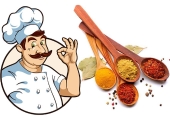


We like to use Gomashio. Its made of ten parts dry roasted sesame seeds and one part salt, ground coarsely in pestle and mortar (or in the kitchen machine). Store in a jar and use like salt. Its a wonderful smell we do love in our dishes... It's part of the Japanese kitchen and sprinkled all over salads and sushi. I even put it sometimes on my porridge. Salt in porridge is more the Scots style though...

 Currently doing a plant identification course and then a plant medicine making course from May. I also watch as many free videos as I can. I always look for the best in their field (I did my Permaculture Designer Certificate online with Geoff Lawton) and Sajah Popham is just amazing and so generous, he gives out so much free information and always in depth. I'm currently watching his Vitalist mini course (would love to do that maybe next year). He has both a scientific and spiritual background as well as Traditional Chinese Medicine and Ayurveda among others and has been able to distill all his knowledge. I've bought his book Evolutionary Herbalism.
Currently doing a plant identification course and then a plant medicine making course from May. I also watch as many free videos as I can. I always look for the best in their field (I did my Permaculture Designer Certificate online with Geoff Lawton) and Sajah Popham is just amazing and so generous, he gives out so much free information and always in depth. I'm currently watching his Vitalist mini course (would love to do that maybe next year). He has both a scientific and spiritual background as well as Traditional Chinese Medicine and Ayurveda among others and has been able to distill all his knowledge. I've bought his book Evolutionary Herbalism.
 Bayer chose meadowsweet to make aspirin the old scientific name was spirea I tthink. It is more gentle on the stomach than willow bark. But I would not recommend without knowing more.
Bayer chose meadowsweet to make aspirin the old scientific name was spirea I tthink. It is more gentle on the stomach than willow bark. But I would not recommend without knowing more.


eric fisher wrote:
I only have access to vermicompost (it's too hot and too dry here to do ordinary composting). I have been making worm compost teas using molasses originally and now have managed to get humic acid and an organic seaweed solution. Any other suggestions? Did try to get fish hydrolyste but couldn't find it locally. I would particularly like to increase the fungal element. I just make the tea in a 5 litre bucket with a bubbler for 36 hours.
Hi Lucy,
You can go a long way with just vermicompost, it is one of those things that is in the awesome category if you look at some of the stats. With your suggestions you already have many of the bases covered. I would go easy on the molasses because even though it helps generate microbial activity it is not so good for diversity which is something you should aim for. Really your question is very open ended if you have a look a the wild plants you have to hand and know what proportion of essential/beneficial elements they contain you can tailor preparations. For a balanced prep you need the big 3 (NPK), then plenty of micronutrients and traces. It is best that whatever you put in has already broken down and been properly composted or been decomposed in some other suitable way such as whizzing it up finely and encouraging some worm action. Just curious now what kind of food web you have where you are and how these critters could be encouraging to participate in your project.
For a fungal element you could proprietary fungal spores or find some oyster mushroom spores, but often they need more preparation measures to get things going. You could also try adding some leaf mold to your mix. Alternatively if you want a greater fungal element you could try the IMO (Indigenous Microorganism Tea) method. For a greater fungal presence it could be as simple as extra woodchip to mulches that have not been treated with retardants etc.



 learned loads! One of the TAs (Teaching assistants) was Will Loughran who was very helpful and he lives in Tenerife so might be a great contact for you. He is on Facebook as Will Loughran.
learned loads! One of the TAs (Teaching assistants) was Will Loughran who was very helpful and he lives in Tenerife so might be a great contact for you. He is on Facebook as Will Loughran.

 Would plan on using a digger for the main excavation rather than doing it by hand.
Would plan on using a digger for the main excavation rather than doing it by hand.